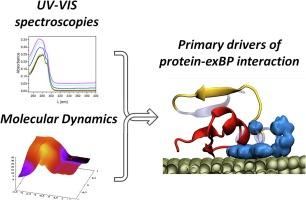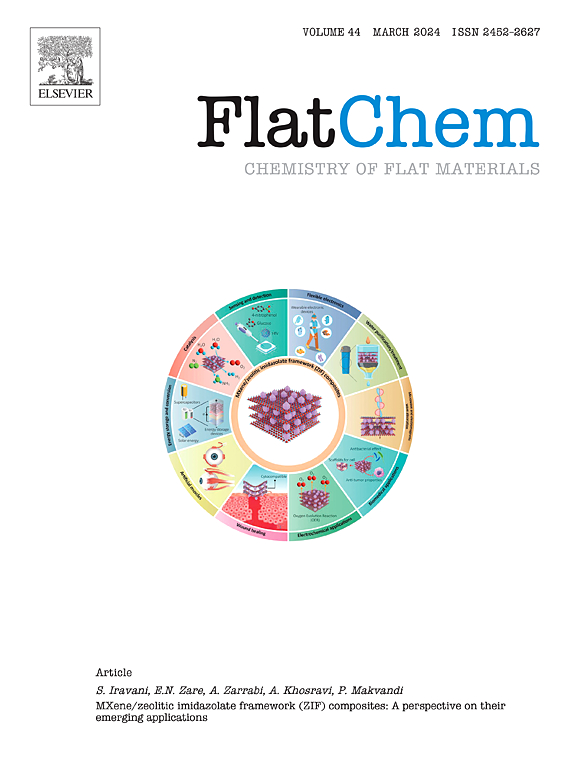Exploring phosphorene-protein interactions: An integrated computational and spectroscopic investigation
IF 5.9
3区 材料科学
Q2 CHEMISTRY, PHYSICAL
引用次数: 0
Abstract
Among 2D materials, exfoliated black phosphorus (or phosphorene) shows great promise for applications in biological domains. However, despite its performances, little is known about the intricate and dynamic interactions that this material can form with proteins. This increases the risk of off-target effects and adds complexity in designing phosphorene-based devices with tailored properties. In this study, we present a straightforward and easily implementable pipeline that integrates spectroscopies with Molecular Dynamics simulations to explore the dynamic interplay between phosphorene and a protein system. Using lysozyme as a deeply investigated reference protein, we employed two theoretical protein models with unique secondary structure folds to increase the descriptive power of the approach and disentangle the complexity and variability of experimental data into a few primary drivers of protein-phosphorene interactions. Our results show that the 2D material does not significantly alter the protein structure, but the observed conformational changes are influenced by the secondary fold. Indeed, while the beta structure interacts mainly through unfolded regions, the alpha fold favours phosphorene binding through structured clusters of residues, leading to more significant structural and dynamic perturbations. By utilizing this pipeline, we have gained valuable insights into the molecular recognition mechanism of phosphorene, enhancing the development of improved phosphorene-based devices. In addition, our methodology offers potential for further applications in biomedicine to characterise interfaces between other 2D (nano)materials and biological entities.

探索磷烯与蛋白质的相互作用:计算与光谱学综合研究
在二维材料中,剥离黑磷(或磷烯)在生物领域的应用前景广阔。然而,尽管这种材料性能卓越,但人们对其与蛋白质之间错综复杂的动态相互作用却知之甚少。这增加了产生脱靶效应的风险,也增加了设计具有定制特性的基于磷烯的器件的复杂性。在本研究中,我们提出了一种简单易行的方法,将光谱学与分子动力学模拟相结合,探索磷烯与蛋白质系统之间的动态相互作用。以溶菌酶作为深入研究的参考蛋白质,我们采用了两种具有独特二级结构褶皱的理论蛋白质模型,以提高该方法的描述能力,并将实验数据的复杂性和可变性分解为蛋白质-磷烯相互作用的几个主要驱动因素。我们的研究结果表明,二维材料不会显著改变蛋白质结构,但观察到的构象变化受到二级折叠的影响。事实上,β结构主要通过未折叠区域发生相互作用,而α折叠则倾向于通过结构化的残基簇结合膦,从而导致更显著的结构和动态扰动。通过利用这一管道,我们获得了有关磷烯分子识别机制的宝贵见解,从而促进了基于磷烯的改良设备的开发。此外,我们的方法还具有进一步应用于生物医学的潜力,可用于表征其他二维(纳米)材料与生物实体之间的界面。
本文章由计算机程序翻译,如有差异,请以英文原文为准。
求助全文
约1分钟内获得全文
求助全文
来源期刊

FlatChem
Multiple-
CiteScore
8.40
自引率
6.50%
发文量
104
审稿时长
26 days
期刊介绍:
FlatChem - Chemistry of Flat Materials, a new voice in the community, publishes original and significant, cutting-edge research related to the chemistry of graphene and related 2D & layered materials. The overall aim of the journal is to combine the chemistry and applications of these materials, where the submission of communications, full papers, and concepts should contain chemistry in a materials context, which can be both experimental and/or theoretical. In addition to original research articles, FlatChem also offers reviews, minireviews, highlights and perspectives on the future of this research area with the scientific leaders in fields related to Flat Materials. Topics of interest include, but are not limited to, the following: -Design, synthesis, applications and investigation of graphene, graphene related materials and other 2D & layered materials (for example Silicene, Germanene, Phosphorene, MXenes, Boron nitride, Transition metal dichalcogenides) -Characterization of these materials using all forms of spectroscopy and microscopy techniques -Chemical modification or functionalization and dispersion of these materials, as well as interactions with other materials -Exploring the surface chemistry of these materials for applications in: Sensors or detectors in electrochemical/Lab on a Chip devices, Composite materials, Membranes, Environment technology, Catalysis for energy storage and conversion (for example fuel cells, supercapacitors, batteries, hydrogen storage), Biomedical technology (drug delivery, biosensing, bioimaging)
 求助内容:
求助内容: 应助结果提醒方式:
应助结果提醒方式:


